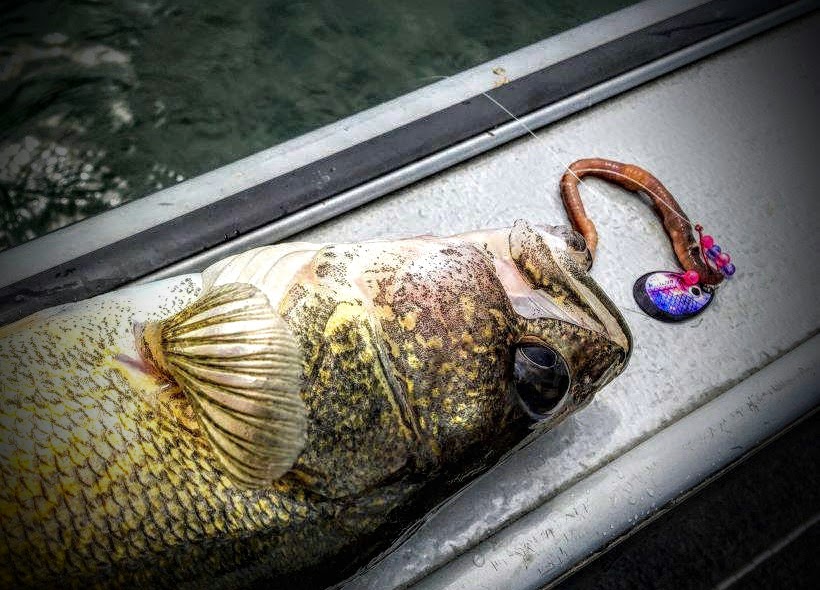Walleye Fishing – Lindy Rigs Basics
I was surprised at the end of last year’s walleye season by a revelation made by two very good walleye fishermen.
These guys come in night after night with fish.
They know what they are doing.
I try to pay attention to the tactics they use when I see them on the lake, but usually we are too busy looking for our own spots and trying our own tactics to pay a great deal of attention.
When I did see them they were usually pitching bait up to shallow areas and pulling it back to the deeper water.
I assumed that they were jigging.
Not too far-fetched considering the fact that jigging is probably the most common way to fish for walleyes.
So I just came right out and asked them at the end of the year what they were doing.
The answer should not have surprised me, it’s a tactic used by walleye fishermen all year long.
They confessed that during the early part of the season, when the water was still cold and the walleyes were moving from their spawning areas they would stick with a jig and a minnow to find their keepers.
But when the water warmed up and the weed beds developed they would go to the good old Lindy rig.
Furthermore … and this is probably more specific to our particular area, they almost always tipped it with a nightcrawler.
There are an unlimited number of ways to put together a Lindy rig … or simply “rig”.
You will get a different “sure fire” answer from any fisherman you talk to, so I will simply stick with the basics.
The Lindy rig is based upon the premise that walleyes are bottom-oriented fish.
Yes, you can find and fish for “suspended” walleyes, but in general they orient to the bottom. So any rig combination is designed to get the bait to where the walleye will most likely strike it.
This type of rig is effective because it allows the bait to swim freely allowing a very natural presentation to finicky walleyes.
How to Make a Lindy Rig
A very basic Lindy rig consists of a hook tied to a snell (see my blog for an illustration).
The length of the snell varies depending upon who you ask. Snell length can range from 2 to 6 feet.
The snell is tied to a barrel swivel.
A slip sinker is then threaded on the line that goes back to the reel, and the snell is tied to that line.
The swivel keeps the line from tangling and also keeps the slip sinker from moving any farther down the snell. The line can move freely through the hole in the slip sinker.
This allows the fish to take the bait without feeling any resistance on the line. Hook size varies depending upon the type of bait being used.
You can buy these rigs already assembled, or you can easily build your own with very basic components.
Variations of the Lindy Rig
There are several variations of this type of rig.
In order to keep the bait above the bottom fishermen will use rigs with a floater of some sort attached to the snell just behind the hook.
There are also a few varieties of floating hook designed to serve the same purpose.
Fishermen who use nightcrawlers will use a “worm-blower” (basically a needle connected to a small bottle to pump air into the crawler) to keep the crawler lively and up off the bottom. In addition to the standard slip sinker, Lindy sells the “No-Snag” sinker, basically a banana-shaped sinker designed to keep the rig from snagging in rocks.
You can also get rigs with spinning blades that you simply slip on the snell and secure a few inches behind the hook … a favorite in this area in mid-July.
Linda Rigs in Practice
Rigs can be fished in a number of ways.
My friends above would simply work their way back and forth over an area casting the rig toward shore and slowly retrieving it.
Others will slowly back-troll through an area.
In these cases, the angler will typically hold the line in their fingers with the bail open on the reel. When they feel a bite they will let the line loose allowing the fish to take the bait and swallow it before it can feel any resistance at the other end, then they will take up the slack and set the hook.
Bait should be hooked in a way that allows it to move naturally.
Minnows should be hooked behind the lips, from the bottom-up.
Crawlers should be hooked once through the nose and inflated with a worm-blower to help keep it suspended above the bottom.
Leeches should be hooked once through the sucker so they can swim naturally, fully-stretched out.


